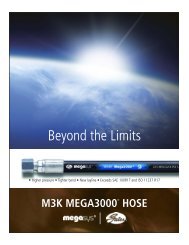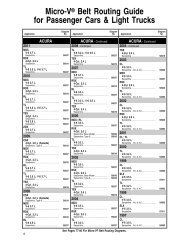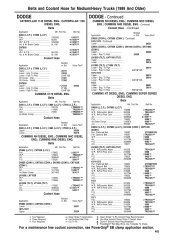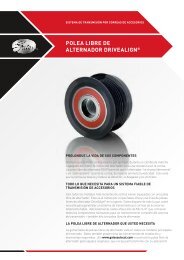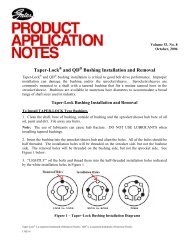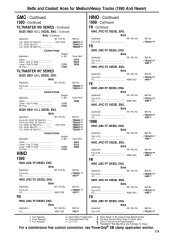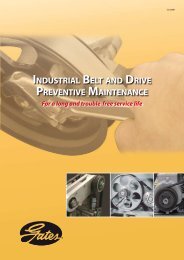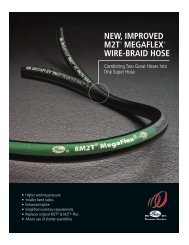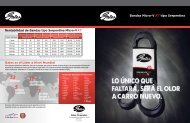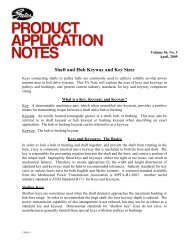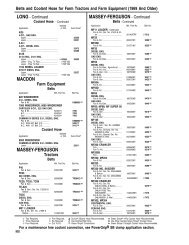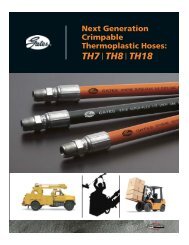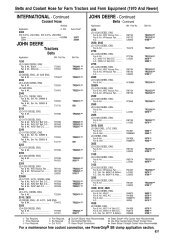PowerGrip® GT® Belt Drives
PowerGrip® GT® Belt Drives
PowerGrip® GT® Belt Drives
You also want an ePaper? Increase the reach of your titles
YUMPU automatically turns print PDFs into web optimized ePapers that Google loves.
Synchronous <strong>Belt</strong> <strong>Drives</strong> – Engineering<br />
V. Idler Usage<br />
— continued<br />
The axes cross at the zero point, or origin. Along<br />
the horizontal, or “X” axis, all values to the right of<br />
the zero point are positive, and all values to the left<br />
of the zero point are negative. Along the vertical, or<br />
“Y” axis, all values above the zero point are positive,<br />
and all values below the zero point are negative.<br />
This is also illustrated in Figure 7 on page 53.<br />
When identifying a shaft center location, each X-Y<br />
coordinate is specified with a measurement in the<br />
“X” as well as the “Y” direction. This requires a<br />
horizontal and vertical measurement for each shaft<br />
center in order to establish a complete coordinate.<br />
Either English or Metric units of measurement may<br />
be used.<br />
A complete coordinate is specified as follows:<br />
(X,Y) where X = measurement along X-axis (horizontal)<br />
Y = measurement along Y-axis (vertical)<br />
In specifying X-Y coordinates for each shaft center,<br />
the origin (zero point) must first be chosen as a<br />
reference. The driveR shaft most often serves this<br />
purpose, but any shaft center can be used.<br />
Measurements for all remaining shaft centers must<br />
be taken from this origin or reference point. The<br />
origin is specified as (0,0).<br />
-10<br />
-8<br />
-6<br />
(-4,7)<br />
-4<br />
(0,0)<br />
10<br />
8<br />
6<br />
4<br />
2<br />
-2 -2<br />
-4<br />
-6<br />
-8<br />
Y<br />
(2,2)<br />
2 4<br />
(3,-1)<br />
6<br />
An example layout of a 5-point drive system is<br />
illustrated in Figure 8. Here each of the five shaft<br />
centers are located and identified on the X-Y<br />
coordinate grid.<br />
When specifying parameters for the moveable or<br />
adjustable shaft (for belt installation and<br />
tensioning), the following approaches are generally<br />
used:<br />
Fixed Location: Specify the nominal shaft<br />
location coordinate with a movement direction.<br />
Slotted Location: Specify a location coordinate<br />
for the beginning of the slot, and a location<br />
coordinate for the end of the slot along its path of<br />
linear movement.<br />
Pivoted Location: Specify the initial shaft location<br />
coordinate along with a pivot point location<br />
coordinate and the pivot radius.<br />
Performing belt length and idler<br />
movement/positioning calculations by hand can be<br />
quite difficult and time consuming. With a complete<br />
geometrical drive description, we can make the drive<br />
design and layout process quite simple for you.<br />
Contact Gates Application Engineering for<br />
computer-aided assistance.<br />
(8,0)<br />
8<br />
10<br />
X<br />
VI. <strong>Belt</strong> Pull<br />
Synchronous belt drives are capable of exerting<br />
lower shaft loads than V-belt drives in some<br />
circumstances. If pre-tensioned according to Gates<br />
recommendations for a fully loaded steady state<br />
condition, synchronous and V-belt drives will<br />
generate comparable shaft loads. If the actual<br />
torque loads are reduced and the level of pretension<br />
remains the same, they will continue to<br />
exert comparable shaft loads. In some cases,<br />
synchronous belts can be pre-tensioned for less<br />
than full loads, under non-steady state conditions,<br />
with reasonable results. Reduced pre-tensioning in<br />
synchronous belts can be warranted in a system that<br />
operated with uniform loads most of the time, but<br />
generates peak loads on an intermittent basis.<br />
While V-belt drives require pre-tensioning base<br />
upon peak loads to prevent slippage, synchronous<br />
drive pre-tensioning can be based upon lower<br />
average loads rather than intermittent peak loads, so<br />
long as the belt does not ratchet under the peak<br />
loads. When the higher peak loads are carried by<br />
the synchronous drive, the belt will self-generate<br />
tension as needed to carry the load. The process of<br />
self-tensioning results in the belt teeth riding out of<br />
the sprocket grooves as the belt enters the driveN<br />
sprocket on the slack side, resulting in increased<br />
belt tooth and sprocket wear. So long as peak loads<br />
occur intermittently and belts do not ratchet,<br />
reduced installation tension will result in reduced<br />
average belt pull with out serious detrimental<br />
effects. Synchronous belts generally require less<br />
pre-tension than V-belts for the same load. They do<br />
not require additional installation tension for belt<br />
wrap less than 180 degrees on loaded sprockets<br />
and V-belt drives do. In most cases, these factors<br />
contribute to lower static and dynamic shaft loads in<br />
synchronous belt drives.<br />
Designers often wish to calculate how much force a<br />
belt drive will exert on a<br />
shafting/bearings/framework in order to properly<br />
design their system. It is difficult to make accurate<br />
belt pull calculations because factors such as torque<br />
load variation, installation tension and sprocket runout<br />
all have a significant influence. Estimations,<br />
however, can be made as follows:<br />
-10<br />
Figure 8<br />
The World’s Most Trusted Name in <strong>Belt</strong>s, Hose & Hydraulics.



